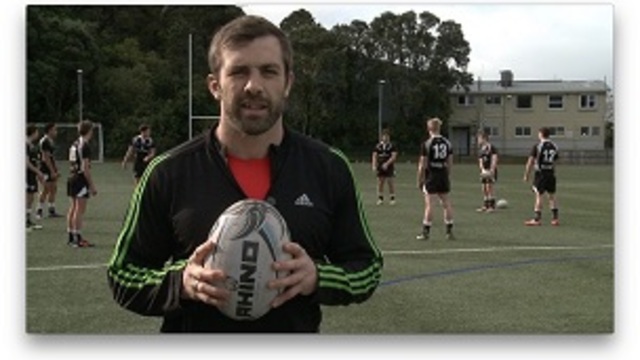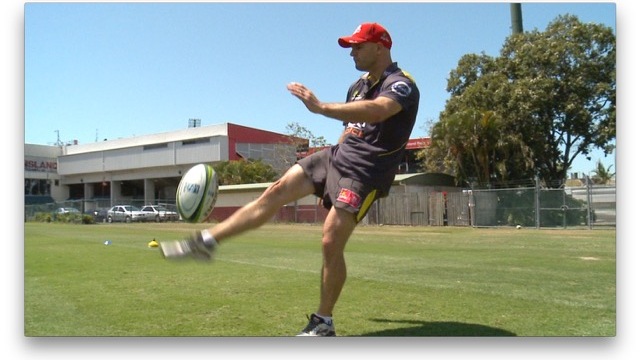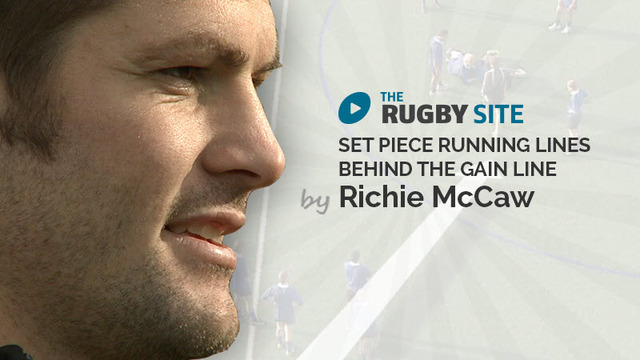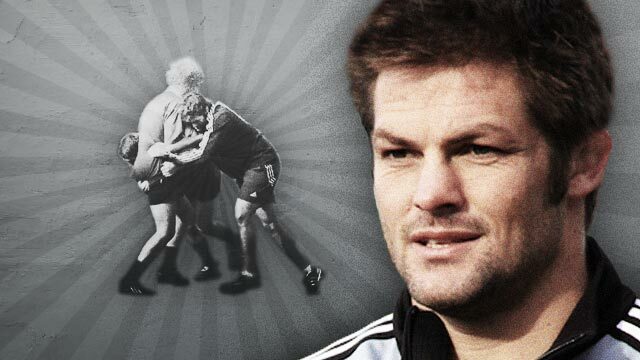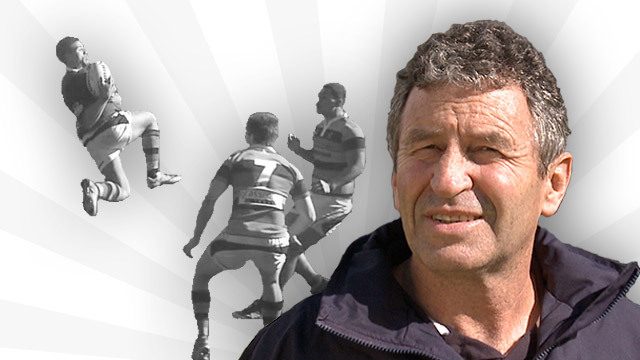Who won the joust of styles at number 9 in Paris? – Part 1
With the 2020 breakdown guidelines now in full force and lightning-quick ball becoming a far more frequent occurrence, the question arising at the elite level of professional rugby is: who is best equipped to use that ball on the next phase of attack? The quicksilver passer who can get width into play very quickly? Or the rugged breaker around the base, who can support at the ruck and regenerate his forwards quickly on the pick and go, and short drives around the base of the ruck?
A classic clash of styles occurred with the two best number 9’s on the planet, Aaron Smith of New Zealand and Antoine Dupont of France, coming into direct confrontation in last weekend’s match in Paris. Smith was specially drafted in for the game after missing the rest of the end of year tour, to provide his trademark super-service as a distributor and attacking thinker. Dupont is probably pound-for-pound, the strongest scrum-half in the world – a huge running threat around the perimeter of the ruck, able to mix it with the opposing forwards and set up his own on the front foot.
In the following pair of articles, I will examine the mechanics of how the different styles can work in harmony with the new breakdown guidelines. Both Dupont and Smith enjoyed very productive games at the Stade de France, despite their contrasting (or diametrically opposite) approaches. The pick and go sequences were especially instructive, in terms of the relationship between the half-back and his forwards.
Let’s take a look at Antoine Dupont first. 60% of the ruck ball in the match was classified as lightning-quick, 0-3 second delivery. That places the halfback under much more pressure than ever, to clean up situations where the ball is released before the attack structure is in place for the next phase of play.
Antoine Dupont’s strength on his feet is the key to France’s ability to create that continuity:
The first cleanout (by France number 5 Paul Willemse on New Zealand hooker Dane Coles) ends on the defensive side of the ruck and leaves the ball quick, but temporarily exposed to attack on the ground. Dupont has the strength to evade the first lunge by Ardie Savea, and push forward through the second contact with Joe Moody, in order to set up a pick & go phase which allows the France attack to regroup.
Even when the preparation for a box-kick was incomplete, and New Zealand were permitted to flood the base of the ruck by referee Wayne Barnes, Dupont was able to rescue the sequence and make a silk purse out of a sow’s ear:
The France halfback is able to withstand the physical pressure applied by Savea and Smith, take the ball forward in contact, and set up prop Cyrille Baille on a ‘settling’ pick & go phase.
Now let’s look at a longer sequence based around the pick & go and short one-out drive, which ultimately led to a try by France.
The phase count started with another ruck save by Dupont:
Two All Blacks again flood through on to Dupont at the base after a long break by Damian Penaud which outdistances his support. Again, he rescues possession and is able to reset the attack via a pick & go – this time by wing Gabin Villiere.
The pick & go, and one-out sequence which followed illustrated the essential differences in the relationship to the ruck between Smith and Dupont:
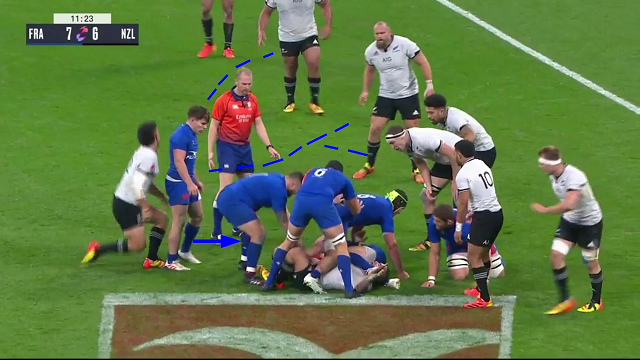
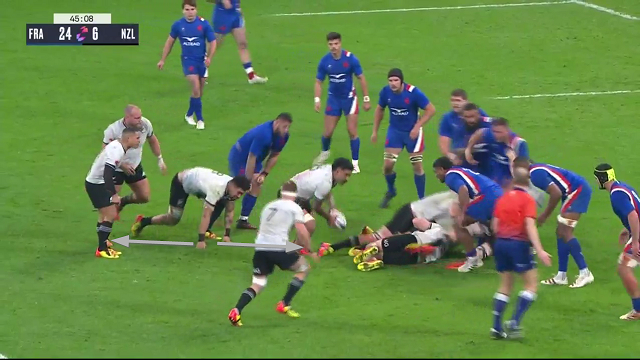
Where Smith is keeping depth, asking his forwards to take the ball on and waiting for the opportunity to widen play, Dupont is right on top of the ruck, looking to take a shot at one of the inside three defenders on the run:
Whether play is coming through a forward (number 4 Cameron Woki), or a back (number 13 Gael Fickou) it is all coming off Dupont’s aggressive positioning at the base of the ruck.
The final stages of the attack illustrate how that aggressive positioning can translate into a meaningful first step up off 9 against the interior defence:
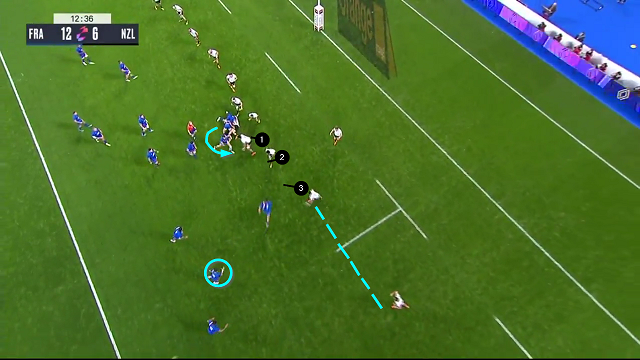
On first phase there is a step outside, on second there is a step outside and a double-pump, and that proves fatal for the first three New Zealand defenders. The step and the pump pull Richie Mo’unga in towards the ruck from “3” and open the space outside him for Romain Ntamack to exploit. There is no time for the defence to recover.
The partner article will explore how a very different species of half-back to Antoine Dupont can be equally effective, by preserving his distance from the ruck and utilizing the flat passing game rather than the running arc around the base.
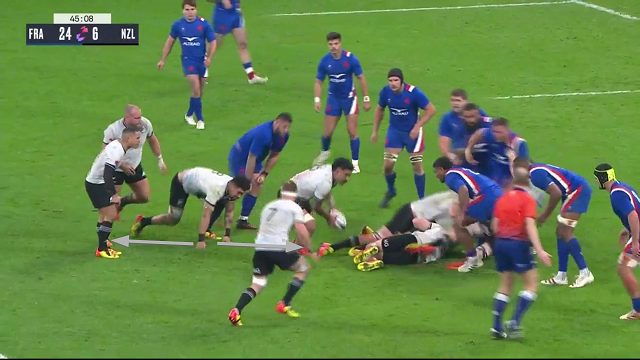




.jpg)
.jpg)
.jpg)





